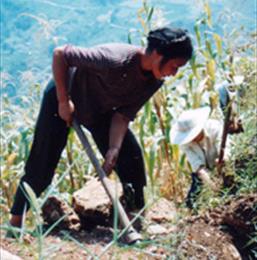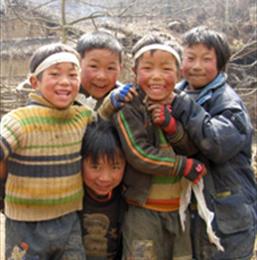Zhushan Village, Hanyuan 1997-1998
 The 5 hamlets of Zhushan Village lie spread out in a diagonal pattern up the side of a mountain in the south west of Hanyuan County. A few horse-trail paths wind their way up the mountain from Henan Township, to the 94 houses of Zhushan.
The 5 hamlets of Zhushan Village lie spread out in a diagonal pattern up the side of a mountain in the south west of Hanyuan County. A few horse-trail paths wind their way up the mountain from Henan Township, to the 94 houses of Zhushan.
The 402 villagers are mostly Han, although there are some Black Yi, White Yi and Tibetans. This part of the county borders on to Liangshan Yi Autonomous Prefecture and some Yi people have moved down from even more remote areas into the higher hamlets of the village. The Black Yi are notable for the women's triangular black, 'hard cloth' head piece, beautifully embroidered waistcoats and skirts with bright bands of oranges and blue. More so than other Yi people in the county, the Black Yi in Zhushan seem to wear some of their traditional clothes on all occasions.
Very few people have occupations outside the village as most are engaged in agriculture tending their household plots and raising livestock. Occasionally men find labouring work outside the village.
Some of the hamlets have a small stream running through them and this is where their water for daily use comes from. This water is polluted as it runs in small earth channels alongside the fields. A few of the households have a plastic water pipe to their houses from a point in the stream higher up than the village in an attempt to get cleaner water although a lot of people must fetch water carrying buckets on shoulder poles.
The houses tend to be made of mud brick. Roofs are tiled with home made roof tiles. The poorest homes have thatched roofs and no stone foundations under part. Some of the wealthier families have built new houses using concrete bricks. The houses in the village are connected to an electricity supply, but few houses have electrical appliances apart from a bare bulb in one room.
In Zhushan the main crops are grown in the summer, these are maize and potatoes. A winter crop of wheat is grown on some of the land but this often fails due to lack of rain . The soil is thin and stony and the fields are just small strips of levelled land clinging onto the hillside. Higher up the mountain side and on the steeper patches there are some trees and scrub vegetation where fuel-wood is collected.
 DORS’ drinking and irrigation water supply project in Zhushan involved piping water from a stream higher up the mountainside down to storage tanks, from where smaller pipes now take clean water into every home in the village, thus solving the village drinking water problem.
DORS’ drinking and irrigation water supply project in Zhushan involved piping water from a stream higher up the mountainside down to storage tanks, from where smaller pipes now take clean water into every home in the village, thus solving the village drinking water problem.
Storage tanks collect excess water to be used for irrigating crops.
Thanks to a donation of five thousand pounds from The Methodist Relief and Development Fund, the project was able to begin in March 1997.
Project Completed in 1998
Assisting Schoolchildren - DORS Education Project
As part of our integrated approach to tackling the problems in Hanyuan's villages, we provide short-term assistance to children from our project villages who do not have the opportunity to attend primary school because their families can not afford the mere 200 RMB primary school fees. We expect that through our other projects in a particular village, such as drinking water in Zhushan, lasting improvements will be achieved, and in time, families will be in the position where they can afford to pay their children's school fees themselves. However due to the poverty that exists in many of the villages where we have projects many children are forced to drop out of school. DORS provides support to the poorest children in our project villages by paying their school fees.
During the implementation of the project in Zhushan, 29 children who would not otherwise have been able to attend school, did so for 2 semesters through DORS' support.
The project in Zhushan Village was completed in October 1997.




